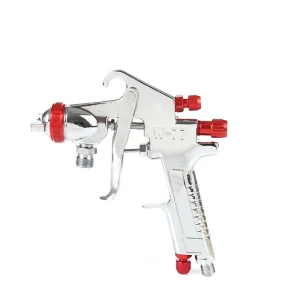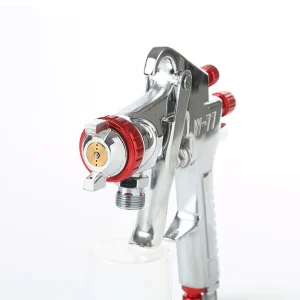Basic Principle and Structural Analysis of Industrial Spray Guns
What Users Care About
Efficiency and Productivity: Users want spray guns that can apply coatings quickly and evenly, reducing downtime and increasing productivity.
Precision and Control: Users need spray guns that allow for precise control over the application, ensuring consistent and accurate results.
Durability and Reliability: Users require spray guns that can withstand harsh industrial environments and provide long-term performance without requiring frequent maintenance.
Cost-Effectiveness: Users are looking for spray guns that offer a balance between performance and affordability, ensuring a return on their investment.
Structural Analysis and Design
Industrial spray guns typically consist of the following components:
- Fluid Section: This section includes the fluid reservoir, pump, and nozzle. It is responsible for delivering the coating material under pressure to the nozzle.
- Air Section: This section includes the air compressor and valve. It provides the compressed air required to atomize the coating material.
- Body: The body houses the fluid and air sections and connects the gun to the operator. It is usually made of durable materials such as aluminum or stainless steel.
The structural analysis of spray guns involves evaluating the forces, stresses, and deflections that occur during operation. This analysis ensures the gun meets safety requirements and provides optimal performance.
The best Industrial Spray Guns manufacturer in 2024
If you want to find a professional Industrial Spray Guns manufacturer, you might as well try sprayguntool. As a professional spray gun manufacturer, sprayguntool can provide you with high-quality products and services. Welcome to contact us for detailed ordering information!
Surface Finish Applications
- Automotive: Painting exterior and interior surfaces of vehicles.
- Electronics: Applying protective and functional coatings to electronic components.
- Furniture: Finishing wooden furniture with lacquers and paints.
- Aerospace: Coating aircraft surfaces with anti-corrosion and high-temperature-resistant materials.
- Construction: Protecting and decorating building surfaces with paints, sealants, and fire-resistant coatings.
Benefits to Users
- Improved Efficiency: Enhanced spraying speed and coverage, resulting in reduced application time and increased productivity.
- Enhanced Precision: Adjustable spray patterns and settings allow for precise coating thickness and uniformity, leading to improved product quality.
- Increased Durability: Rugged designs and robust construction materials ensure long-term performance in demanding industrial environments, reducing maintenance costs.
- Cost-Effective: Optimized designs and efficient operation contribute to lower operating costs and an attractive return on investment.
Advantages and Features
| Feature | Benefit |
|---|---|
| High-Pressure Design: Delivers uniform and consistent spray patterns, resulting in a smooth and professional finish. | |
| Precision Control: Adjustable nozzles and valves provide precise control over the application, allowing for tailored coating thickness and desired effects. | |
| Ergonomic Design: Lightweight and comfortable handles reduce operator fatigue, leading to increased productivity and efficiency. | |
| Interchangeable Parts: Modular designs enable quick and easy replacement of worn parts, minimizing downtime and maintenance costs. | |
| Wide Range of Applications: Suitable for a variety of coating materials and surface types, offering versatility in industrial settings. |
Expertise and Figures
Expertise:
- Materials Science: Understanding the properties of coating materials and their interaction with spray guns.
- Fluid Mechanics: Analysis of fluid flow, atomization, and spray patterns.
- Structural Engineering: Evaluation of forces, stresses, and deflections in spray guns.
- Ergonomics: Designing for operator comfort and efficiency.
Applications of Industrial Spray Guns
- Painting: Applying paints, lacquers, and other coatings for protection, durability, and aesthetics.
- Coating: Depositing functional coatings such as anti-corrosion, anti-fouling, and fire-resistant materials.
- Dispensing: Applying adhesives, sealants, and lubricants for assembly and bonding.
- Etching: Using abrasive materials to create patterns or remove surface layers.
- Cleaning: Utilizing high-pressure water or solvents to remove dirt, debris, and contaminants.
Benefits of Industrial Spray Guns
| Feature | Benefit |
|---|---|
| High Efficiency: Automated or semi-automated processes improve productivity and reduce labor costs. | |
| Uniform Coverage: Precise control over spray parameters ensures consistent and uniform coatings on various surfaces. | |
| Reduced Waste: Precise application minimizes overspray and material waste, resulting in cost savings. | |
| Improved Safety: Enclosed systems and remote operation minimizes operator exposure to hazardous materials. | |
| Versatile Applications: Suitable for a wide range of materials and surfaces, offering adaptability in industrial settings. |
Experience Tips
- Choose the Right Spray Gun: Consider the type of coating material, surface type, and desired application speed.
- Adjust Spray Parameters: Experiment with different nozzle sizes, air pressure, and fluid flow to achieve the optimal spray pattern.
- Proper Maintenance: Clean and lubricate the spray gun regularly to ensure smooth operation and extend its lifespan.
- Wear Protective Gear: Use proper personal protective equipment (PPE) such as masks, gloves, and eyewear.
- Train Operators: Provide proper training to operators to ensure safe and efficient use of the spray gun.
FAQ
1. What is the difference between a pneumatic spray gun and an HVLP spray gun?
A: Pneumatic spray guns use compressed air to atomize the coating material, while HVLP (High Volume Low Pressure) spray guns use a high volume of low-pressure air to create a finer mist.
2. How do I choose the right nozzle size for my spray gun?
A: The nozzle size determines the spray pattern and flow rate. Larger nozzles produce wider spray patterns and higher flow rates, while smaller nozzles produce narrower patterns and lower flow rates.
3. Why is maintenance important for spray guns?
A: Regular maintenance helps prevent clogs, leaks, and other issues that can affect the performance and lifespan of the spray gun.
4. What is the best way to clean a spray gun?
A: Disassemble the spray gun and clean all parts thoroughly with a solvent compatible with the coating material. Use brushes and rags to remove any paint buildup or debris.
5. Can I use a spray gun to apply different types of coating materials?
A: Yes, spray guns can be used to apply a wide range of coating materials, including paints, lacquers, stains, and adhesives. However, some spray guns may require modifications or special nozzles to accommodate certain materials.






